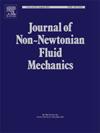赫歇尔-布克雷流体中层流平面水力跃迁的数值研究
IF 2.8
2区 工程技术
Q2 MECHANICS
引用次数: 0
摘要
通过实验和使用 Herschel-Bulkley (HB) 模型进行数值模拟,研究了水平通道中粘塑性液体流动过程中的层状平面水力跃迁。模拟采用了带有 Papanastasiou 正则化参数的相场方法,并与实验结果进行了验证。实验和模拟结果都表明,自由表面高度在跃迁上游逐渐增加,在跃迁后逐渐减小,跃迁处的自由表面高度和表面波浪度显著增加。该模型进一步显示,在其他特性保持不变的情况下,流变参数[屈服应力 (τo) 流动特性指数 (n) 和流动稠度指数 (k)]的任何一个增加都会增加薄膜厚度。这增加了跳跃强度,并使跳跃向入口方向移动。然而,每个参数都以不同的方式影响自由表面轮廓和跳跃特性。较高的τo 会抑制剪切区的发展并导致较厚的堵塞区,而较高的 n 会增加剪切区厚度并减少堵塞区厚度。另一方面,k 越大,剪切区和堵塞区的厚度都会增加。模拟得到的不同跃迁类型以非量纲坐标相图的形式呈现,是一种通用方法。本文章由计算机程序翻译,如有差异,请以英文原文为准。
A numerical investigation of laminar planar hydraulic jump in Herschel-Bulkley fluid
Laminar planar hydraulic jump during viscoplastic liquid flow in a horizontal channel is investigated through experiments and numerical simulation using Herschel-Bulkley (HB) model. The simulations are performed using the phase-field method with Papanastasiou regularization parameter and validated against experimental results. Both experiments and simulations show the free surface height to gradually increase upstream of jump and recede after the jump with a remarkable increase in free surface height and surface waviness at the jump. The model further reveals that an increase in any of the rheological parameters [yield stress () flow behaviour index (n) and flow consistency index (k)] keeping the other properties constant increases film thickness. This increases jump strength and shifts jump towards the entry. However, each parameter influences free surface profile and jump characteristics in a different way. While a higher τo suppresses the development of the shear zone and results in a thicker plug zone, a higher n increases shear zone thickness and decreases the plug zone thickness. On the other hand, a higher k increases both shear and plug zone thickness. The steady state fully developed self-similar velocity profile is independent of k and depends on and n. Different jump types, obtained from simulations, are presented as phase diagrams in non-dimensional coordinates for a generalised approach.
求助全文
通过发布文献求助,成功后即可免费获取论文全文。
去求助
来源期刊
CiteScore
5.00
自引率
19.40%
发文量
109
审稿时长
61 days
期刊介绍:
The Journal of Non-Newtonian Fluid Mechanics publishes research on flowing soft matter systems. Submissions in all areas of flowing complex fluids are welcomed, including polymer melts and solutions, suspensions, colloids, surfactant solutions, biological fluids, gels, liquid crystals and granular materials. Flow problems relevant to microfluidics, lab-on-a-chip, nanofluidics, biological flows, geophysical flows, industrial processes and other applications are of interest.
Subjects considered suitable for the journal include the following (not necessarily in order of importance):
Theoretical, computational and experimental studies of naturally or technologically relevant flow problems where the non-Newtonian nature of the fluid is important in determining the character of the flow. We seek in particular studies that lend mechanistic insight into flow behavior in complex fluids or highlight flow phenomena unique to complex fluids. Examples include
Instabilities, unsteady and turbulent or chaotic flow characteristics in non-Newtonian fluids,
Multiphase flows involving complex fluids,
Problems involving transport phenomena such as heat and mass transfer and mixing, to the extent that the non-Newtonian flow behavior is central to the transport phenomena,
Novel flow situations that suggest the need for further theoretical study,
Practical situations of flow that are in need of systematic theoretical and experimental research. Such issues and developments commonly arise, for example, in the polymer processing, petroleum, pharmaceutical, biomedical and consumer product industries.

 求助内容:
求助内容: 应助结果提醒方式:
应助结果提醒方式:


